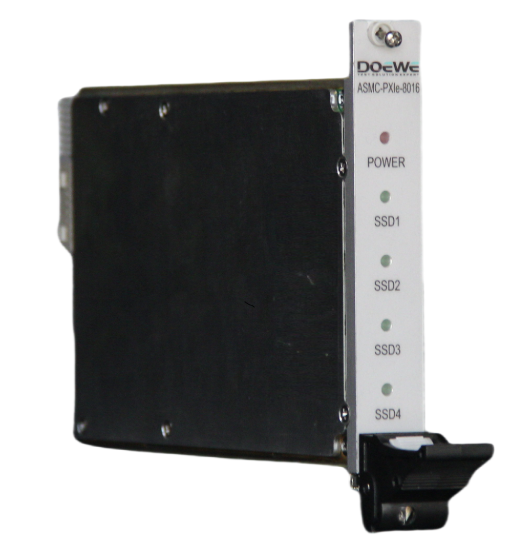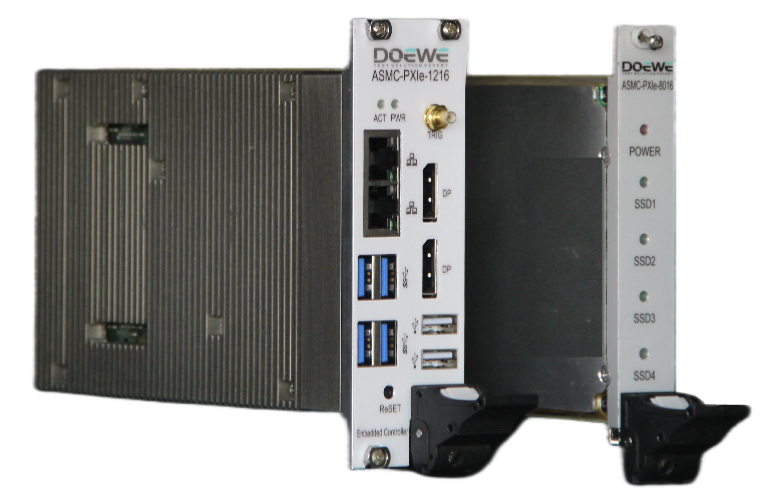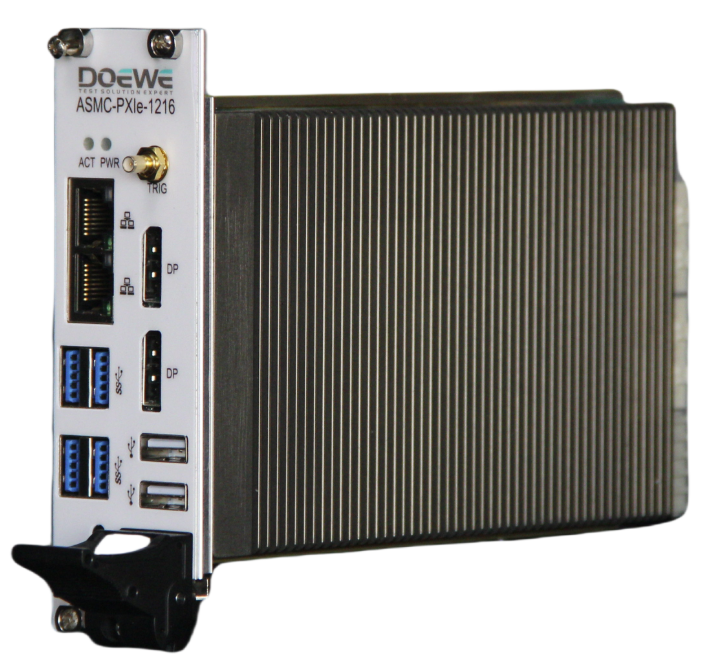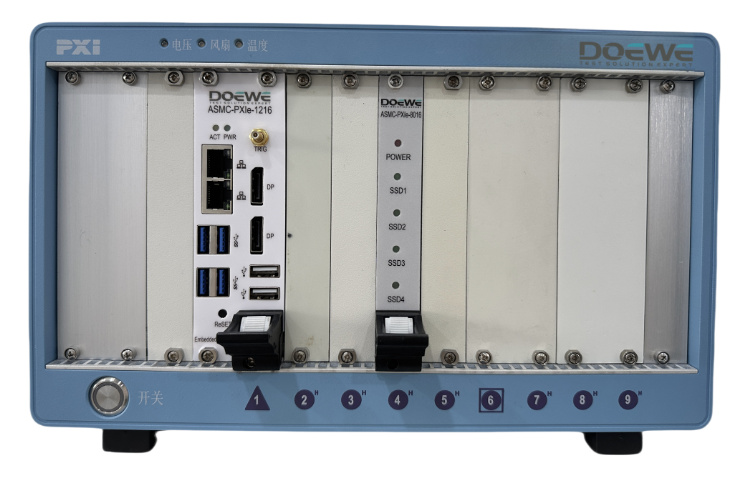Data Acquisition (DAQ) systems play a vital role in modern testing and measurement, undertaking the critical tasks of acquiring, processing, and analyzing high-precision data. With the rapid advancement of computer technology, bus technology, and communication technology, the hardware architecture of DAQ systems has evolved from early foundational structures to today's high-performance, low-latency architectures. Currently, common DAQ system architectures mainly fall into four categories: cPCI, cPCIe, PXI, and PXIe. These architectures each possess distinct characteristics and advantages in terms of performance, bandwidth, modular capability, and application domains. This article will introduce their development processes and respective features, analyzing their roles and prospects in modern testing applications.

Figure 1 PXIe Storage Card
cPCI(CompactPCI)
cPCI (CompactPCI) first appeared in 1994, evolving from the PCI standard. It aimed to address some limitations of traditional computer systems in industrial automation, test and measurement, and embedded fields. Compared to traditional computer architectures, cPCI adopted the standard PCI bus and incorporated various hardware improvements, making it better suited for the demanding requirements of industrial and embedded systems. cPCI design emphasized interference resistance and stability, making it particularly suitable for high-demand application environments like industrial and military settings, where it saw widespread adoption.
As a modular architecture, cPCI offered high flexibility. Users could expand system functionality via slots according to needs, facilitating easier system upgrades and maintenance in practical applications. However, as application demands grew, cPCI began to reveal bottlenecks in areas like data transfer rates and expansion capabilities: it did not support hot-swapping and could not achieve inter-card synchronization. This spurred the development of the next generation of high-performance DAQ system architectures.
PXI(PCI eXtensions for Instrumentation)
To overcome some limitations of cPCI, PXI (PCI eXtensions for Instrumentation) emerged. Proposed by National Instruments (NI) in 1997, PXI introduced significant optimizations based on cPCI. PXI not only inherited the modular architecture of cPCI but also incorporated more advanced high-speed backplane communication technology and precise clock synchronization mechanisms, greatly enhancing system scalability, bandwidth, and real-time performance.
One of PXI's major innovations was the introduction of high-speed clock signals and synchronization functions. This ensured multiple modules within the system could synchronize with extremely high precision, enabling more efficient coordinated work. This feature was particularly suited for high-performance data acquisition, complex signal analysis, and precision testing applications, meeting the needs for real-time data processing. Furthermore, PXI supported a wider variety of measurement modules, leading to its widespread adoption in laboratory testing, automated testing, and industrial monitoring, establishing it as a standard architecture for high-end test systems.
Despite these architectural optimizations, PXI still utilized the PCI bus transfer protocol, meaning it inherited PCI's limitations. Specifically, PXI faced constraints in data transfer rates and bandwidth, unable to match the latest transfer technologies. Additionally, the PCI protocol itself did not support hot-swapping, so PXI systems also lacked this capability. These technical limitations could become bottlenecks for system expansion and real-time response in specific applications.

Figure 2 PXIe Card
cPCIe(CompactPCI Express)
With the continuous development of computer bus technology, cPCIe (CompactPCI Express) emerged as the upgraded version of cPCI. cPCIe introduced advanced PCI Express (PCIe) technology, significantly boosting system bandwidth, latency, and scalability, making it particularly suitable for applications requiring high-speed data transfer. Unlike traditional cPCI, cPCIe adopted a point-to-point connection method, supporting faster, lower-latency data transfer, thereby greatly improving overall system performance. Since its release in 2005, cPCIe's compatibility with existing PCIe slots on computer motherboards allowed better integration with modern computer architectures, enhancing adaptability and flexibility.
The introduction of cPCIe provided stronger support for large-scale data acquisition, real-time signal processing, and precision testing applications. Compared to traditional cPCI, cPCIe could handle more sensors and signal channels and supported larger-scale system expansion, meeting the demands for higher performance and more complex tasks. Especially in fields demanding high data bandwidth, such as large-scale data acquisition, real-time signal processing, and precision instrument testing, cPCIe demonstrated excellent performance, becoming the ideal choice for these applications. By significantly enhancing performance and expansion capabilities, cPCIe not only met demanding application requirements but also made processing complex tasks more efficient and reliable.
Despite cPCIe's advantages over traditional cPCI and PXI systems in many aspects, it still had some shortcomings. A major limitation was its inability to provide the high-precision inter-card synchronization offered by PXI systems. PXI, designed specifically for test and measurement applications, supports high-precision clock synchronization and triggering mechanisms, enabling multi-card systems to work together precisely. This synchronization capability is crucial in applications requiring multi-channel coordination, especially real-time signal processing and large-scale data acquisition scenarios. However, cPCIe primarily focused on providing higher data transfer rates and scalability, offering weaker support for inter-card synchronization control. This meant it could not fully replace PXI systems in certain high-precision synchronization applications.

Figure 3 PXIe Controller
PXIe(PXI Express)
PXIe (PXI Express), a further evolution of the PXI standard released in 2005, adopted the high-speed connection technology of PCI Express. Compared to traditional PXI, PXIe offers higher bandwidth and lower latency, significantly increasing data transfer rates to meet demands for higher real-time data acquisition and processing. By utilizing PCIe's point-to-point connection method, PXIe not only improved the performance of single cards but also enhanced the capability for multi-card cooperative work.
The advent of PXIe greatly elevated the performance of PXI systems, particularly excelling in complex applications like high-frequency signal acquisition, large data volume processing, and multi-module cooperative work. It inherited the modular design, flexibility, and precise inter-card synchronization advantages of the PXI standard while supporting higher throughput and more features. This led to its widespread adoption in high-end testing, measurement, and complex system integration fields. PXIe's high performance and high scalability make it the architecture of choice for many test and measurement systems requiring high precision and high throughput, especially in industries like aerospace, automotive electronics, communications, and semiconductors.
Through its unique technological advantages, PXIe quickly became the mainstream for high-end test and measurement systems, serving as the ideal choice for applications demanding extreme precision, bandwidth, and real-time performance in many industries. However, compared to cPCIe, PXIe, while possessing a clear advantage in inter-card synchronization, involves a performance trade-off. The additional synchronization mechanisms and clock signal management in PXIe, essential for guaranteeing high-precision cooperative work between cards, often result in lower per-slot data transfer rates than cPCIe. Therefore, although PXIe excels in multi-card synchronization and complex system integration, cPCIe retains an irreplaceable advantage in certain applications requiring extremely high bandwidth.

Figure 4 PXIe Chassis
Conclusion
cPCIe and PXIe each have their applicable strengths and characteristics. When selecting a DAQ system, the specific application requirements dictate which architecture is more suitable. For applications requiring large-scale data transfer with relatively lower synchronization demands, cPCIe is undoubtedly an ideal choice. For high-end test and measurement systems requiring multi-card cooperation and high-precision synchronization, PXIe holds the advantage.
From cPCI to PXI, and then to cPCIe and PXIe, the evolution of DAQ systems not only witnesses the continuous progress of computer bus technology but also reflects the ever-increasing demands of test and measurement. Each generation of technology builds optimizations upon the previous, offering higher bandwidth, superior synchronization performance, and stronger system expansion capabilities. As the performance of DAQ systems continues to improve, future systems will evolve towards greater modularity and intelligence. These systems will better address increasingly complex and high-precision testing needs, meeting the multifaceted challenges of real-time performance, bandwidth, and accuracy across different fields, driving technological innovation and industry development.
Doewe Technologies remains committed to delivering innovative, unique, and reliable product solutions in the data acquisition field. We understand deeply that these elements are the cornerstone for enterprises to stand firm in market competition. Therefore, our innovation is inspired by the real application needs of our customers, not merely to showcase flashy product features. Through continuous optimization and enhancement of data acquisition solutions, Doewe Technologies empowers partners to move towards an efficient and precise future. Welcome to choose Doewe Technologies and jointly open a new chapter in data acquisition.